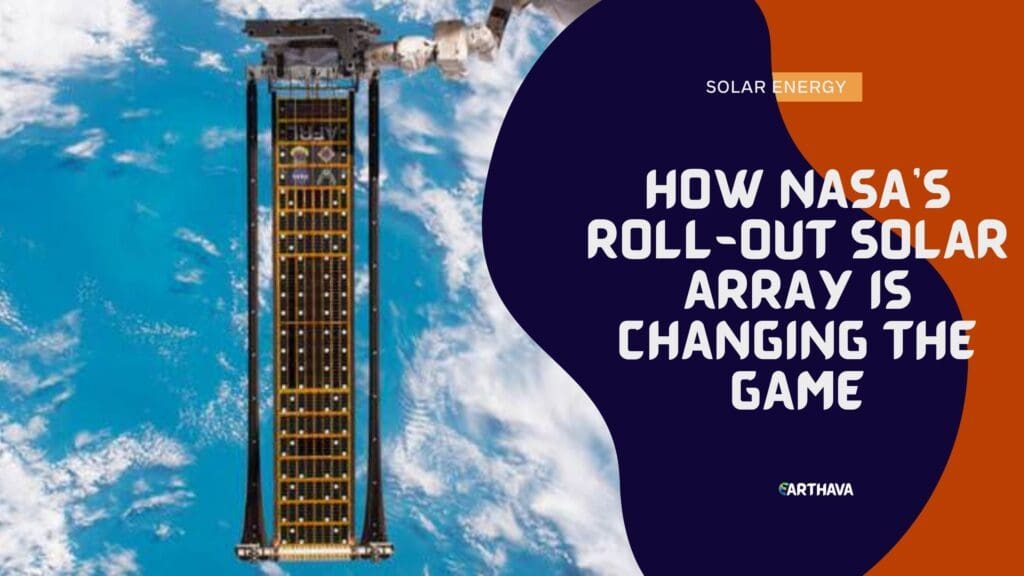Solar arrays are an effective and efficient way to power spacecraft. They are the only reliable source of power for most satellites we have in orbit as well as space probes and rovers we sent to other planets, including Mars and Jupiter.

However, there is one problem with solar panels – they are large and delicate. Also, to collect solar rays to power a spacecraft, they must be unfolded while on the surface of another planet. On satellites, they can only be unfolded in space. Moreover, the rigid design is not flexible and compact.
Everything will change soon, though, thanks to a new innovative solar array design developed by Deployable Space Systems, NASA, and the Air Force.
What is ROSA?
Meet the Roll-Out Solar Array (ROSA). It’s a flexible and lightweight array that rolls out in space like a tape measure. This design provides much more flexibility than rigid panels, so it can be stored anywhere on a spacecraft and rolled up and stowed when not in use.
The heart of ROSA is a center wing produced using an incredibly flexible material containing photovoltaic cells. These cells effectively convert light into electricity at the atomic level. Supporting the center wing on the sides are two narrow arms made of a stiff composite material.
ROSA was delivered to the International Space Station (ISS) on June 5 by the SpaceX Dragon cargo spacecraft. The trip actually made history because it was the first time when a privately built ship made a repeated delivery to the ISS.
According to NASA, ROSA has a number of advantages compared to current solar panels:
- It rolls out and rolls up to form a compact cylinder
- It’s lighter and smaller than the current heavy panels
- Rolling and snapping operations are conducted without a motor
- It can be adapted to different sizes
- It provides more power without increasing the mass.
The Goals of The ISS Experiment
ROSA was delivered to the ISS for a specific purpose. First and foremost, the experiment tested the durability and strength of the structure. These results will tell NASA how well it deploys in extreme temperatures and microgravity of space. Future satellites and spacecraft carrying ROSA will need to maneuver, so the array will be exposed to extreme vibration levels.

Second, ROSA was deployed in the full sun to test how it collects the light and how vibrations affect its performance. Third, the scientists want to evaluate its ability to handle retraction.
On Earth, NASA has already tested ROSA in a simulated environment (vacuum chambers) and produced a lot of interesting results. However, the only way to test the device is to send it into space. The results from the ISS experiments will be compared to the results of the test done on the ground to produce reliable data.
What does that mean for Space Exploration?
These incredible features of ROSA mean that exciting times are ahead. For example, the future weather satellites, radio and television satellites, GPS satellites, and others will become incredibly compact and lighter weight.
If ROSA testing is successful, it can become a critical factor for the success of both human and robotic missions to other planets. For example, it will give Mars landers and rovers more flexibility in terms of traveling on the surface. Also, when not in use, the arrays could be rolled up to protect them from radiation on the Martian surface.

Also, it can help to make the journeys of robotic explorers beyond Mars easier.
For example, the Juno spacecraft that recently arrived at Jupiter had enormous solar arrays with a span of about 20 meters that increased the total weight to 7,992 pounds (3,625 kilograms) at launch. According to a NASA Press Kit, the total surface area of solar arrays at Juno was more than 650 feet (60 meters) squared. Below is a picture of Juno’s massive solar arrays.
Given that ROSA is at least 20 percent lighter and 4 times smaller in volume than current solar rigid panels, it could significantly decrease the mass of future spacecraft. According to Jeremy Banik, a senior researcher at the Air Force Research Laboratory, the new technology provides enormous cost savings.
Given that the launch in space is pretty much about volume and weight, ROSA could be a much more cost-effective solution compared to the current solar array technology.
How did the Test Go?
Using the ISS’s robotic arm Canadarm2, engineers on Earth have rolled out ROSA. This operation lasted almost two days (17th and 18th of June). It was covered by many news agencies around the world. “A lot was expected from this technology,” says Ben Greene, a journalist.
After the array was deployed, the scientists performed a number of successful operations that produced a lot of useful data. After the week of testing, they needed to get the array back inside the Dragon vehicle that delivered it to the space station.
Unfortunately, the engineers failed to retract ROSA. After a number of unsuccessful attempts to lock the panel back in its stowed configuration, they decided to jettison it directly from its location at the Canadarm2. Here is the image of the device being jettisoned from the ISS.

This scenario was also planned by NASA, so the released device will not present any danger to the ISS and vehicles visiting it in the future.
What Now?
According to NASA, the agency has no plans to retrieve the array so it’s safe to assume now that it will continue to float in space alongside the ISS for several months. Even though the mission failed to return ROSA to the Dragon spacecraft’s external payload bay, it produced a lot of results that will improve the design of solar arrays used in space. Already, some manufacturers of telecommunications satellites, including SSL, have selected ROSA technology for their spacecraft.
After staying in orbit for at least a few months, the array will give up to the atmospheric drag that will pull it back for a destructive re-entry.




